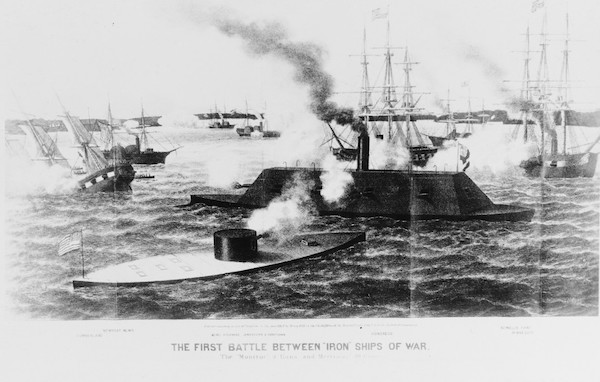“Warships of Sea and Space”
Form Follows Function Follows Technology by Jim Beall
The shapes of both ships and planes have always depended on technology, so it should come as no surprise that space warcraft should be similarly affected. Such design considerations go back to the earliest warships.
Although usually equipped with sails, the earliest warships were generally propelled in battle by oars. Weapons were both short ranged and inaccurate, especially on those small, moving and pitching platforms. Unsurprisingly, ramming and boarding became the standard tactics. The earliest recorded naval battle appears to be the Battle of the Delta, fought about 1175 BC, when the Egyptians led by Ramses III repulsed a major invasion by the Sea Peoples. (Note 1)

Battle of the Delta
(Source: Wikipedia—Public Domain)
Until this time, the Egyptians appear not to have even had a word for "warship" and had to create one. (Note 2)
Many notable innovations did occur despite the technology constraints of manual warship propulsion. One of the most significant was the Roman "Corvus" (Note 3), introduced in the First Punic War, that allowed Legionnaires to board and capture Carthaginian galleys. Bows, ballistae, onagers, and crossbows (Note 4) were just some of the weapons used with the intent to kill or disrupt enemy crew to facilitate boarding. Grappling hooks were particularly effective. (Note 5)
Warship designs hardly changed at all conceptually for well over the next two millennia! Hulls grew broader but remained much more slender than their cargo-hauling contemporaries, trading capacity for faster oar-propelled sprints, and with prows designed for inflicting damage by collision. Even the early naval cannons were slow to impact warship design, as their short range combined with long reload times meant the enemy could close to board before a second shot could be fired. In fact, the primary use of those first guns was to inflict crew casualties to assist in boarding—the same role as the ballistae of antiquity.
The Battle of Lepanto (1571) has often been cited as marking the beginning of "The Age of Sail," as it was the last fleet battle where all of the nearly five hundred combatants were oar-propelled designs.
Battle of Lepanto, 1571
(Source: Wikipedia—Public Domain)
The new "Age" resulted from improvements in cannons in the years following Lepanto that allowed warships to destroy enemy combatants (or compel surrender) prior to boarding. As a result, warship design changed dramatically. Ships became larger and beamier than oarsmen could propel, because greater size and breadth made them better gun platforms (and more resistant to projectile damage). Masts and sails—previously limited in size and extent due to ram impact effects—increased in height and area to drive the larger ships through the water. Galleys still proved useful in special circumstances, such as becalmed conditions (Note 6), or as counters to threats posed by their opposite numbers in confined waters. Nonetheless, oar-propelled warcraft soon disappeared from fleets; the advance in weapons technology had radically changed warship design.
One-on-one ship battles shifted from hand-to-hand brawls to something more like pistol duels. Only when one vessel and its crew became seriously degraded would boarding actions typically take place, and often not until the losers had struck their colors. Enemy fleet engagements tended to become ranged affairs much like contemporary land battles between blocks of musket-equipped soldiers. The effects of wind direction on maneuverability and waves on gun ports became serious tactical considerations, and many battles were decided by suboptimal decisions concerning them. One such was the Battle of the Chesapeake during the American Revolution. The wind direction allowed the French to use their lower gun ports, while the British could not. (Note 7)

Battle of the Chesapeake, September 5, 1781
(Source: U.S. Government Image—Public Domain)
Just as the Battle of Lepanto signaled the beginning of "The Age of Sail," so did another battle mark its end: the "Battle of Hampton Roads," between the steam-powered ironclads CSS Virginia and the USS Monitor (1862). The engagement followed Virginia’s easy destruction and neutralization of a Union sailing ship squadron, showing that wooden ships driven by the winds could not hope to defeat armored ships powered by steam.
Battle of Hampton Roads, March 9, 1862
(Source: Naval History and Heritage Command—Public Domain)
As had happened when sails replaced oars, warships again leaped in tonnage as steam power produced much more driving force than wind-pushed sails (and also independent of wind presence, strength, or direction). A massive convulsion of ship redesign followed with wood giving way to iron and steel, and sailing masts being replaced by steam boilers and propellers. Naval guns moved into turrets (like the Monitor) or behind armored bulkheads (like the Virginia)—some designs had both.
Sailing ships soon left the fleets of world navies. Naval warship design had once again been revolutionized, this time by the advance in propulsion technology associated with the new "Age of Steam."
One interesting (and perhaps counter-intuitive) result was the revival in the pre-Sail Age attack of ramming! That is, the new technology of steam allowed ships to maneuver, gain speed, and drive into the enemy far better than oar galleys had been able to do. In the American Civil War, the navies of both sides used steam-powered, paddle-boat rams to considerable effect. Indeed one such vessel (CSS General Sterling Price) rammed and disabled Union ships in multiple engagements, was sunk in battle, raised, and put into service in the Union Navy (as USS General Price) where it served for the remainder of the war. The Battle of Lissa (1866) between forces of Austria and Italy also featured ram tactics. The result was that many navies built rams for a few decades, and included "ram bows" in many of their warships for even longer.
Ram attacks were feasible in the early years of steam because gun and shell technologies initially lagged that of armor (once steam propulsion allowed smaller freeboard and greater than previous armor thickness). The point here is that new technologies can revive previous dead-end tactics. Nor did SF ignore this. In H. G. Wells' 1897 War of the Worlds, HMS Thunder Child (a fictional torpedo ram in the Royal Navy) heroically engaged three alien fighting machines by shelling and ramming while defending a convoy of refugees, destroying at least two before succumbing. In homage, many authors and game designers have included vessels named Thunder Child in their storyverses ever since, including Star Trek.
Major fleet combatants continued to grow in size over the next several decades. Armor would get thicker and guns larger, and all the while steam technology advances continued to produce ever more powerful engines. The demands and complexity of the designs soon outpaced the ability of most nations' shipyards to construct them. (Note 8) The costs of these huge warships rose to the point where only the Great Powers could build and sustain fleets, few nations could construct the shipyards capable of producing them, and most could not even afford to purchase a single one from a foreign shipyard. (Note 9)
The belief in the importance of having one or more such ships in a nation's navy was not mistaken. Smaller ships mounting lesser guns and thinner armor could not hope to defeat larger adversaries in battle or, in many cases, even harm them. A nation without any was at the mercy of any other nation that had even one. Lesser ships looked like they might become relegated to duties away from the heart of battle, such as scouts or raider protection.
Soon, however, technology advances once again changed naval design and, by doing so, created the need for new ship types. Some designs specifically targeted the great-gunned, thickly armored, and vastly expensive vessels. Others then became necessary to operate in support of those compatriots to help ward off the new threats.
The first of these advances was the torpedo. (Note 10) The significance of this weapon was that it could damage or sink even the largest warships, yet be launched by small vessels difficult to destroy at a distance, especially when attacking at speed in numbers. This advance in weapons technology mandated new classes of warships with different characteristics. The new designs were optimized to better launch the new weapon or to defend the fleet against such attackers, and some to fulfill both roles. The new attacking ships sacrificed armor for speed and agility. The new defenders needed to be nearly as fast and armed with guns optimized for engaging the quick but unarmored attackers. The key point, however, is that these new warship designs did not arise until weapons technology produced the new threat.
The torpedo also led to a new warship of an entirely different type: the submarine. In this case, the new design was built simply to employ the new technology, rather than modifying existing designs to incorporate it. Here, the new technology dictated the creation of a class of warships completely unrelated to any previous ones.
The second technological advance was the airplane. The first generations of these posed no direct threat to armored warships. However, improvements in range and reliability soon enabled planes to find enemy ships at distances far beyond naval scouts and improve long range gun accuracy as shell spotters. (Note 11) At first, ship designs changed only modestly, mostly by simply the addition of a seaplane or two, so as to be able to utilize these potential advantages to the ship’s benefit. (Note 12) Some proponents advocated for a new class of ships dedicated solely to operating airplanes, with the thought of greater scouting capabilities and the potential to gain an advantage for their large gunned warships by driving off enemy scouts and spotters.
Continued aviation technology improvements in speed, range, and lift eventually made them direct threats to even the most heavily armored warships. (Note 13) The result was another new warship class, the aircraft carrier, far larger than the seaplane tenders for air scouts. Meanwhile, all ship designs were steadily modified, with the most visible changes being the addition of massed batteries of anti-aircraft weapons. One good example is the USS Pennsylvania (BB-38), with the images below providing a clear contrast of before and after air attacks were considered a clear threat.
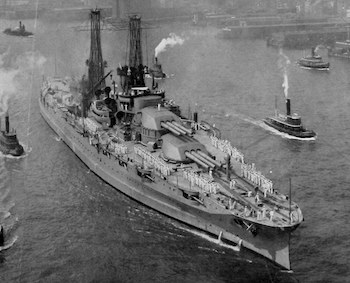 |
 |
USS Pennsylvania, BB-38—As-built (1918) and after Pearl Harbor Rebuild (1943)
Source—Official U.S. Navy Photographs (cropped)—Public Domain
Besides replacing the existing secondary armament with new five-inch twin turrets (dual purpose, capable of anti-aircraft fire), ten quad mounts of forty millimeter and fifty-one twenty millimeter anti-aircraft guns were installed, thus adding an additional ninety-one barrels dedicated solely to shooting at attacking aircraft. As these changes were being made, all new ship designs were modified as well to increase anti-aircraft weapons. A new class of light cruisers (CL) emerged gunned only with weapons able to shoot at aircraft (CLAA).
The last technology that changed naval warship design to be examined is electronics, the changes occurring over the last fifty years.
First, the new weapons changed the dimensions of the battlespace, pushing fleet engagement ranges far beyond the reach of conventional naval artillery and, in doing so, rendered large gun warships effectively obsolete as naval surface combatants. Like galleys, nearly four centuries before and sailing ships hardly one century earlier, they increasingly served in limited niche roles before disappearing altogether from the navies of the world.
Second, once steam, armor, and heavy cannons had become the basic warship elements at the start of the Age of Steam, the designs themselves became "mass limited." That is, the capabilities of the warship were directly affected by changes in mass, such that increases in mass improved the ship by thickening armor, increasing gun number/caliber, adding shaft horsepower, and/or other attributes. The advent of electronics and missiles changed the designs to "volume limited." Heavy armor was no longer used. Massive gun barrels and their heavy shells were replaced by slender launchers and low density missiles. The new requirement to keep electronics cool mandated multiple air conditioning plants, with large capacity ducts. Now, increasing the volume of a ship increased its performance by allowing greater numbers and more powerful missile and electronic systems to be incorporated into the design.
This effect can be tracked in the three images below. The first is USS Chicago, one of the last large, pre-missile warships, completed in 1945 as a heavy cruiser (CA-136). The second image is the same ship after its conversion in 1964 to a guided missile cruiser (CG-11). The third image below "the Chicagos" is the USS Ticonderoga (CG-47) guided missile cruiser, built from the start as a volume-limited design.
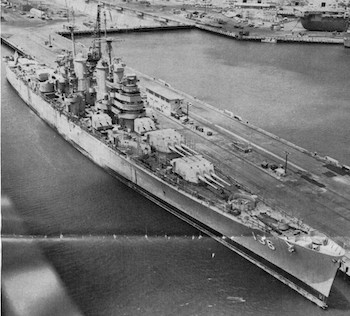 |
 |
| USS Chicago, CA-136 | USS Chicago, CG11 |
USS Ticonderoga, CG-47
Source—Official U.S. Navy Photographs (cropped)—Public Domain
The USS Chicago was originally commissioned with armored main turrets and numerous anti-aircraft guns. The conversion design replaced all the main guns (and nearly all the others) with missiles, added missile directors and more powerful radars, and increased volume where practicable. The Ticonderoga design plainly maximizes volume to the point that it begins to resemble more a box on a hull (Note 14) than the cruisers that came before her. These changes were the natural result of optimizing the design for electronics and missiles.
The spaceships of science fiction (SF) follow the same principles traced above in the naval vessels of history. In SF, however, the author posits the technologies, allowing vast variances among authors and "storyverses." One persistent theme in the history of SF is that the fictional ships have often been extrapolations from the most advanced technologies present in the real world when the authors wrote their stories.
Jules Verne's From the Earth to the Moon (1865) was written nearly forty years before the Wright Brothers took to the sky at Kitty Hawk, North Carolina. The best technology then in existence for getting a mass to a high altitude was the cannon. Thus, Verne extrapolated to a massive cannon that fired an inhabitable projectile (nine feet in diameter!) that would fly to the Moon. It achieved this by detonating so much gunpowder that it was visible for scores of miles, knocked down all anywhere nearby, and was recorded as a meteor burning up in the atmosphere by ship captains as far as a hundred miles out to sea. The point here is not realism (or lack of same, as the acceleration forces necessary would have crushed all passengers into paste), but that the shape or design of the "spacecraft" was that of a cannon shell. Verne may have been the first to use this design, but he was far from the last. (Note 15)
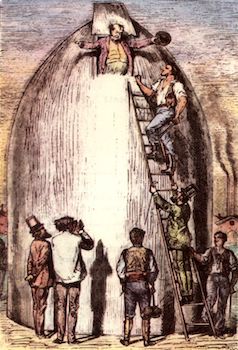 |
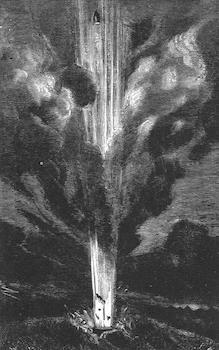 |
The "Spaceship" and Its Launch
Jules Verne—From the Earth to the Moon
Source: Wikipedia—Public Domain
The Excelsior was perhaps the first SF spaceship in motion picture history. It appeared in the movie, "Himmelskibet" ("A Trip to Mars"), a silent feature film released in 1918. (Note 16)
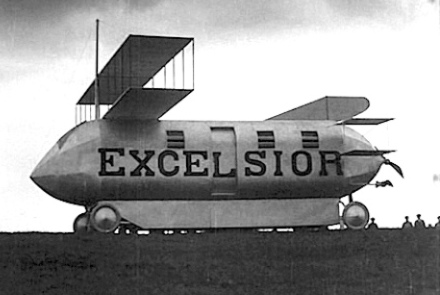 |
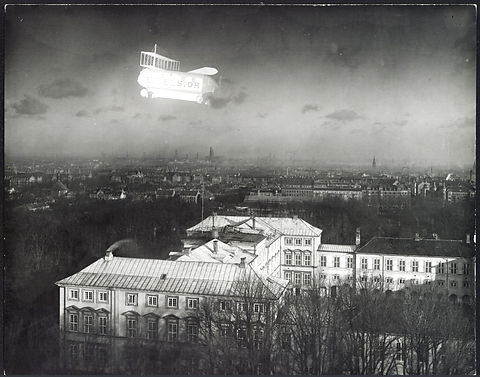 |
| The Excelsior Spaceship | The Excelsior in Flight |
Source: Stills (Cropped) from the 1918 Film, "Himmelskibet"
Public Domain (Note 17)
The design of the Excelsior combined the two best flight technologies of the time: biplanes and dirigibles! It even had a pusher propeller on the back. These technological aspects dictated the shape of the craft.
Within a decade of the release of "Himmelskibet," airplanes had become so commonplace and well understood (including their limitations) that they were no longer SF spaceship fare. Rockets came next and an especially notable early example was Frau im Mond (1929), by Thea von Harbou. Translated from German, it became known variously as The Girl in the Moon, Woman in the Moon, and Rocket to the Moon, depending upon editions. This was an extraordinary work in many respects, and then it was made into a movie which itself contained many nearly prescient elements.
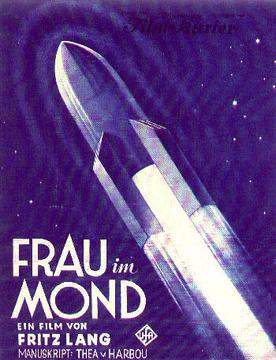 |
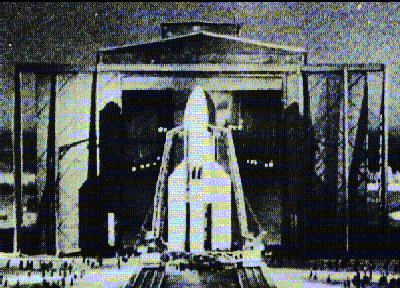 |
| Book Cover | Movie Still |
| Source: Wikipedia—Public Domain | Source: NASA Image—Public Domain |
The author consulted German rocket developers while writing her novel and screen play and their influence showed. Among the many details of technical (Note 18) interest:
—Size of the rocket, roughly equivalent to Saturn V,
—Constructed in a tall building and then rolled upright to launch point,
—Multi-stage rocket, ejected first stage in flight,
—Crew reclined horizontal during launch due to acceleration forces, and
—Crew used straps in space due to weightlessness.
Rockets soon dominated SF, and came in a great many designs ranging from unadorned to highly decorated. Two of the most famous are from Buck Rogers (introduced 1928) and Flash Gordon (first appearance 1934).
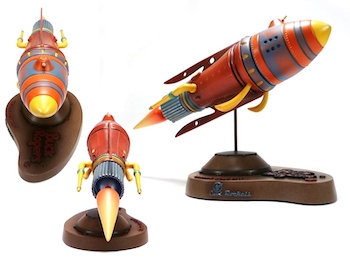 |
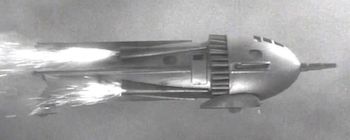 |
| Buck Rogers' Battlecruiser | Rocket Ship from Flash Gordon |
| (Courtesy of CoolRockets.com) | Source: Wikipedia—Public Domain |
| (Note 19) | (Note 20) |
Rocket spaceships continued to roar across the covers of SF novels and magazines in the decades that followed, as well as in serials and feature films. The specific design elements varied, but most generally featured long cylinders and fins. They were armed with a wide variety of weapons, including rocket guns, atomic mortar guns, space bombs, heat rays, gas launchers, and many more. The shape, speed, and agility of rocket powered attack craft apparently brought back memories of days of yore to some. As happened in early in the Age of Steam, the new technology revived interest in a previously discarded tactic: ramming! (Note 21)
Pulp magazine covers in particular regularly featured bright, energetic images that excited the imaginations of young readers. One of the earliest and most influential artists was Frank R. Paul, hired by Hugo Gernsback in 1914 to illustrate a science magazine. Gernsback next tasked him with the cover of the inaugural issue (April, 1926) of his Amazing Stories magazine. This was the first magazine dedicated to science fiction, and Paul's work appeared on all the covers for over three years. His images of huge robots, streaking spaceships, and strange aliens were the first such images seen by a great many future SF artists and authors, as well as young readers considering careers in science. (Note 22)
The next generation of authors included Frank Kelly Freas and Chesley Bonestell. Freas was amazingly prolific as an artist and would be nominated twenty times for the Hugo Award for Best Artist and win ten. (Note 23) The style of his drawings of spaceships and exotic locales was so distinctive that they were easily identifiable.
Many of Bonestell's paintings included not only spaceships, but also the locales where they operated or had landed. His experience in photography, miniature modeling, and astronomy helped him create images of breathtaking realism and impact. His 1944 "Saturn as Seen from Titan," (see below) was so convincing that it seemed photographers must have set up on that distant spot.
"Saturn as Seen from Titan, 1944"
(Image Confirmed in Public Domain by Bonestell LLC)
Geza Gyuk, vice president of Astronomy, Research and Collections at the Adler Planetarium in Chicago, described (Note 24) his influence as follows:
“Bonestell's work was seminal in the birth of the Space Age. His paintings invoked a sense of location, causing a generation to grow up thinking of the worlds of our Solar System as real places to which we could journey. His was the inspiration that launched a thousand careers.”
In the decades after World War II, rockets soon became sufficiently commonplace (Note 24) that SF writers sought and invented new technologies, essentially broadening their technology palate significantly.
Well thought out fictional systems, however, imply design attributes just as technologies do in the real world. One early and highly popularized example of the transition from rockets to such a new technology can be seen in, of all places, the Tom Swift, Jr. series.
The new series first appeared on the scene in 1954 with the publication of no fewer than five separate novels! Tom Swift and His Rocket Ship was one of those first five. The protagonist was the son of the main character of the predecessor series (forty books, 1910 - 1941) and typically featured a new invention (as had the original series). Visually, his "Rocket Ship" design followed the basic decades-old pattern of the sleek and pointed cylinder, multiple fins, and fire-spouting from the back. Just four years later, however, the new spacecraft invention in Tom Swift in The Race to the Moon looked entirely different.
 |
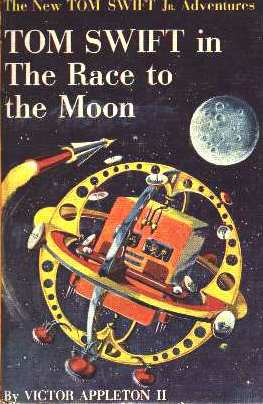 |
| Tom Swift and His Rocket Ship | Tom Swift in The Race to the Moon |
| 1954 | 1958 |
| (Author's Collection) | (Author's Collection) |
Gone were the fins on a streamlined silhouette atop a fiery plume. Instead, readers were greeted with what looked like a huge box built inside a massive gyroscope! The vehicle ("Challenger") probably looked equally weird to rocketeers as the USS Monitor had to veterans of the Days of Sail. Yet, as odd as it appeared, Challenger's design was just as consistent with its new technology as the Monitor had been four years shy of a century before the Tom Swift book's publication.
Challenger did not use rockets as main propulsion, but "repelatrons" which could push against things like planets for propulsion (and against meteors for protection). Since the thrust could be gradual and steady, there was no need for the design to concern itself with wind resistance. Since the repelatrons could be swiveled, thrust could be gained in any direction, obviating the need for fins while making a spherical shape an obvious way to maximize their arcs. In short, the design form followed the function and the technology!
This theme would be repeated over and over in SF with well thought-out fictional technological systems. For example, the "Starfire" series, originated by David Weber and Steve White in 1990, began based on the game system by the same name (created by Stephen V. Cole in 1979). The fundamental design technologies were rocket-style engines, missiles, beam weapons (Note 25), shields, armor, and wormholelike interstellar transportation. Within those boundaries, ship types vary significantly. Some classes sorted by weapons, with several devoted mainly to missiles, and others to beams. Other types sorted by mission, with sensor platform vessels at one end of the design spectrum and heavily armored and shielded semimobile bases at the other.
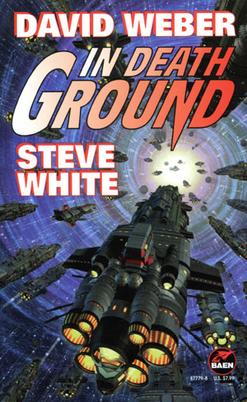 |
 |
| In Death Ground 1997 | Stars at War II 2005 |
| (Author's Collection) | (Author's Collection) |
The images above are from the covers of two of the many books in the series. (Note 26) Note that the ship designs on the In Death Ground image vary somewhat as they approach a wormhole ("warp point") reflecting the human tactics there. On the other hand, the ships emerging from the warp point on the The Stars at War II cover are identical, consistent with the alien race tactic of using one class for that mission.
An additional design aspect in the Starfire series is that fighting power increased with ship mass and volume (combining the historical elements of the Age of Steam and the effects of electronics). Greater size historically meant more defense (armor), firepower (weapon projector number and size), missile capacity, and electronics capability. The fiction parallels that, though the systems are considerably different. The unusual SF element is that different species see different ways to utilize the greater size. The humans see the chance to include larger missiles and heavier beams, while the "Orions" see them as higher capacity strike fighter bases.
In effect, the different attitudes reprise the historical debates around World War II about the relative importance and roles of the battleship versus the aircraft carrier. The two species champion two completely different ship types to make the best use of the same increase in size. In the SF series, however, the outcome of the debate is uncertain, as technologies can change especially as each race focuses on developing ones that improve their choice. Here, then, "Form Follows Function Follows Technology Follows Species Mindset."
The next novels of interest are those in "The RCN Series," by David Drake, with the cover of the first book in the image below.
With the Lightnings 1998
(Author's Collection)
The technologies assumed by Drake in this series are far different from the ones in Weber's Starfire series. There are no shields, no warp points, and no energy beam weapons (beyond very short range, mostly for missile defense). Ships must take off from planetary surfaces. Faster than light (FTL) travel is effected by a drive that transitions the vessel into "bubble space" and then, once there, extending telescoping tall masts with sail-like surfaces to allow Casimir effect force on them to "push" the ship.
The spaceship designs must conform to these factors and result in far different vessels in appearance than the Starfire ones. Even the largest RCN warships cannot begin to match the size of the Starfire craft because they must be able to stand upright in planetary gravity (with all its mass on whatever struts or fins might be provided) and then take off under its own power. Pure beam ships serve no purpose since those weapons cannot damage enemies beyond impractically close range. Even small ships, however, pose mortal threats to the largest because of the absence of shields to defeat missiles. This allows smaller, more agile craft to be useful in fleet battles due to their abilities both on defense and offense.
Other SF series with distinctive forms based on posited technologies include Star Trek. Warp drive FTL, advanced shield technology, teleportation, food replicators, and antimatter power plants are just a few of the series technologies which affect ship design. With two warp cores posited to be optimum and their radiation dangerous, ships designs generally have two nacelles attached to the main hull but extended a considerable distance away from inhabited areas. This can be seen not just in Human designs, but in those of the Klingons and Romulans, to name but two. This would appear to significantly degrade hull strength, but "structural integrity shields" handle that. These two factors lead to a plethora of exotic ship designs that have to "obey the Star Trek rules" but are largely unimpeded by most others, including inertia, gravity, and atmospheric constraints. (Note 27)
In many stories, authors shape their technologies by "working backwards" to fit the stories they want to write. In some cases, the intent might be to replicate historical conflicts in future settings. In other cases, it may have been to allow certain desired tactics. One interesting case is presented in The Mote in God's Eye (1974), by Larry Niven and Jerry Pournelle.

The Mote in God's Eye 1974
(Author's Collection)
The novel is set in a far future setting within a previously established (by Pournelle) storyverse ("CoDominium"). (Note 28) The fictional technologies include an FTL drive, shields, missiles, and beams, but the authors craft a way within their tech to include boarding parties by Marines. Like ramming, this tactic appears implausible on its face, but the storytelling appeal is so great that many authors orchestrate ways within their posited high technologies to achieve it nonetheless and readers appear not to complain! In this and similar cases, the function came first, then the form, and then the technological "loophole" needed to make it happen. Thus, the phrasing might more properly be, "Technology Follows Form Follows Function"!
If boarding enemy starships is a major story element, authors can also use a very different approach, as Dave Grossman and Leo Frankowski did in The Two-Space War (2004).

The Two-Space War (2004)
(Author's Collection)
The storyverse posits that FTL is not possible, that is, within the three dimensional universe. To go faster than light, one has to go flat! Instead of using massive warp engines or stargates, starships are sailing ships because engines of any type require three dimensional moving parts. Sails, however, are two-dimensional! Ship-to-ship duels and fleet engagements are fought with cannons right out of the Napoleonic Era, with sword-slashing boarders often settling matters precisely as Roman Legionnaires did in the First Punic War. The story is admittedly fanciful to the extreme but a great read. In this author's humble opinion, any story that contrives to have ship cats duel alien vermin, while loyal dogs battle aliens alongside their human allies can never be bad!
Authors telling stories in more "pure" hard SF style always have to balance real-world technology and fictional "handwavium." The choices each writer makes to achieve the setting and capabilities are a major part of reader enjoyment.
For example, without truly advanced technologies, major beam weapons might not be practical at all aboard ships. Space is a vacuum, making shedding heat slow and inefficient. Waste heat from generating and channeling the energy necessary for high-powered beamers would quickly overwhelm a ship's systems. Indeed, firing even one of the mighty broadsides so popular in SF would likely destroy the attacker before the beams ever reached the target! Square miles of superconductor radiators would be necessary for each dreadnought main beam weapon. (Note 29) It would also be easy to "see" and target the glowing ship. Alternatively, a large ship could have a massive internal heat sink (large tanks of ice slurry, perhaps), fire a few shots, and then disengage for several hours until the now-hot heat sink could be rechilled. (Note 30)
The above are formidable challenges to any author in telling a story. The three most common solutions are to ignore the problem (historically, by far the most common approach), use beam weapons only in close quarters as brief missile defense (David Drake's RCN series uses this approach very well), or employ technologies not present in the real world.
Nor are missiles without their own real-world issues. Given the vast ranges of most space battles, the flight times become so great that countermeasures would appear always to have a decisive upper hand. Reducing this time window via huge missile velocities requires handwavium of its own, due to the missile internals having to withstand thousands of gravities of acceleration, let alone the propulsion system and fuel required to achieve it.
One SF solution to the missile problem is to reduce missile acceleration somewhat and lower the engagement ranges. In these cases, the defense retains much of the upper hand, but not all of it. What the attacker must do, instead, is to use lots of missiles. The technological handwavium lessens significantly, but the author now has the additional challenge of justifying the massive missile quantities required. This means that ship designs must support such numbers or the battlespace itself has to be managed to allow the missiles to otherwise be present. The "Troy Rising," series by John Ringo (first book, Live Free Or Die, 2010) definitely uses the "many missiles" approach, as the cover of the third book clearly demonstrates.

The Hot Gate (2011)
(Author's Collection)
Another missile problem solution is to reduce missile technology and engagement ranges even further, along with missile defenses. Much less handwavium is required but one major consequence is that probable battle locations become fewer. That is, the low ranges render deep space meeting engagements very unlikely, making battles seem mostly restricted to choke points (like wormhole openings) or deep within solar systems. The RCN series by David Drake uses this approach.
Another solution to beam and missile problems is to "handwavium" them all away. Posit warships with massive engines, equipped with ultra-long range missiles with tens of thousands of g's acceleration, powerful beam weapons of staggering variety, shields with stunning resistance, and then tack on the vast multitude other technologies needed to make it all both coherent and consistent. To build such ships would require spaceyards tens of cubic miles in volume with several hundred thousand workers operating mostly-robotic machinery the size of skyscrapers. Sustaining that technological infrastructure would require more than one star system. Sustaining it for book after book after book would require more than one author.
This brings U.S. to the "Honorverse" series created by David Weber, first book On Basilisk Station (1993).
On Basilisk Station (1993)
(Image Courtesy of Baen Books)
In this series, the author not only wanted large-scale fleet battles between very large FTL warships, but also wanted them fought with mighty broadsides of both missiles and beams. Additionally, important duties and missions were desired for smaller ships, both in those same battles and on detached missions. The posited technologies and settings to enable such battles to seem reasonable require considerable structure of their own. Consider the image below:
Honorverse Minotaur class LAC carrier, 6,178,500 tons, 1131 × 189 × 175 meters
(Image by BuNine, courtesy of Baen Books)
Clearly the infrastructure necessary to field a fleet of ships that size (some were larger) would be immense. In fact, the fleet tonnage of the two largest warship classes in the protagonist's navy alone was portrayed as over two billion tons.
Consider next the hull shapes of the two larger space vessels in the above image. Both are compact, double-ended cylinders with most (or all) weapons mounted in broadsides. Many other storyverses mount much of any warship's armament aiming forward. Weber wanted broadside battles, so ship design form followed function and technology came last, adjusted as necessary to make it happen.
The technologies and analyses required to continue beyond a couple books were significant. Where did the waste heat go? How could bows and stern be vulnerable despite shields? How did planetary defenders detect invading fleets approaching in FTL? How many g's did the missiles have to sustain to be effective, and how did they do that? Technologies would improve over time during an extended series, but which ones and how? New technologies might create new designs (like submarines in the real world) that would potentially upend the status quo—avoid or embrace? These are merely a few of the many questions to be addressed for the series to continue.
In the earlier Starfire series, Weber and White worked within the fictional structure of an established gaming system, playtested and otherwise exercised by a great many people. As the Honorverse stories grew in number and scope, keeping the overall structure consistent and coherent posed increasingly tough challenges. These might have been enough for many authors to pull back and start a fresh series. Perhaps to avert that, a support team of fans formed with resumes including aviators, naval analysts, military veterans of multiple services, professional artists, and IT professionals. (Note 31) They called themselves BuNine, and the name stuck and even became a legal entity! BuNine continues (Note 32) to help the author as consultants to maintain coherence and consistency, as well as explore the implications and effects of potential technology changes.
In summary, history shows that warship design changes with technology, sometimes adding threats that are totally new, while other times restoring threats previously rendered obsolete. SF history is replete with warship designs based on extrapolations of known technology, but also with ones using handwavium tech. The reasons behind the technologies chosen by the author also vary, with some choosing ways to retell stories from history or tell new ones that will feel familiar to readers despite the futuristic settings. Gadget SF featured the invention as the story, but modern SF makes the technologies more a part of the setting. In space warships, the same applies. That is, it matters little which came first, the technology, the form, or the function. What matters most is the story and, if it is good enough, fans will eagerly step up to help with all three.
Notes
1) Recorded in stone! The battle description is inscribed (with drawings!) on Ramses III’s mortuary temple at Medinet Habu. The drawing is a detail from an upper corner of one wall. For a complete and authoritative rendition of the many Ramses III temple inscriptions, see the 1930 University of Chicago Press document, "Earlier Historical Records of Ramses III," by the Epigraphic Survey. This magnificent work can be found on-line at:
https://oi.uchicago.edu/sites/oi.uchicago.edu/files/uploads/shared/docs/oip8.pdf
2) The literal translation of the new term has been rendered as, “ships of fighting (in the heart/midst of the sea)” by one source and “ships–of–warriors–on–the–sea” by another. See: https://dash.harvard.edu/handle/1/34903185.
3) Battle of Mylae, 260 BC—for more details, see the author's earlier article available on this site, From Corvus to Keyhole: Shipyards—Past, Present, and Science Fiction.
4) Julius Caesar references his "ships of war" driving off barbarian attackers by "slings, arrows, and engines." (Commentaries on the Gallic War, Book 4, Chapter 25)
5) Grappling hooks appear to have been used at the Battle of the Delta, with the Egyptians casting them into rigging and pulling on the lines to capsize enemy vessels. Archimedes would use them to defend Syracuse in, from the Roman point of view, a most effective and terrifying way. See "Claw of Archimedes," also known as "Archimedes Iron Hand."
6) For example, during the Battle of Orbetello (June 14, 1646), galleys towed the artillery-heavy galleons of both forces into position due to light winds. Sailing warships would also use their rowed small boats on other occasions when becalmed.
7) Also called the "Battle of the Virginia Capes." This engagement was indecisive tactically, but decisive strategically because the failure to drive off the French fleet and support the British land forces led to the British surrender at Yorktown. The British admiral was criticized for his choice of tactics, including his failure to engage more closely. Allowing the battle to remain one of maneuver greatly increased the chance of a draw which, for the British, was a war-ending defeat. The British admiral returned to New York, repaired damage, and set off again to return and reengage, but his departure was two days after the surrender at Yorktown.
8) Construction times also lengthened, requiring the long-term application of a great many skilled workers on each vessel. Gone were the days when Venice's Arsenale shipyard could build a warship in a day. Once, in 1574, the Venetians had even built, launched, and armed one in a single hour to impress King Henry III of France. (Frederic Chapin Lane, Venetian Ships and Shipbuilders of the Renaissance, New York, Arno Press, 1979, p. 144)
9) Possessing a "dreadnought" in a nation's navy became such a status symbol in the years leading up to World War I, that several nations contracted with Vickers (Britain) or AG Vulcan (Germany) to build them despite the ruinous expense.
10) Torpedo was originally the name given by Robert Fulton to his invention (first demonstrated in 1800) of an underwater gunpowder charge towed into position and detonated by a timer. The term became the word used for what are now called naval "mines." During the Battle of Mobile Bay (August 5, 1864) when Admiral David G. Farragut ordered, "Damn the torpedoes . . . full speed [ahead]," he was referring to the risk of mines, one of which had just detonated and sunk the monitor, USS Tecumseh. The invention of a mobile underwater weapon with similar properties was initially called a "locomotive torpedo" after the style of motion, or "Whitehead torpedo," after its inventor.
11) Smoke (from fires, muzzle blast, and steam plants) limited the reporting of where a ship's shells landed with respect to the target to allow correction. Designs soon incorporated armored boxes high above the water surface, but even under optimum conditions, the curvature of the Earth itself prevented observing the impact points at the maximum ranges of the largest guns. Airplanes flying overhead equipped with wireless communications equipment had the potential to dramatically improve gunfire accuracy and range.
12) Commander Charles Rumney Samson was the first British pilot to take off from a ship (January 10, 1912) and then from a ship underway (May 9, 1912). The redoubtable Samson was one of the first air pioneers in the Royal Navy (the Royal Navy Air Service or RNAS) and would go on to have a remarkable career. One of his anecdotes was perhaps the first engagement of two new technologies. On May 27, 1915, he attacked the U-21 that had just sunk HMS Majestic. When he ran out of hand-bombs, he continued by firing at it with his rifle. The first successful attack on a submarine by aircraft appears to have been suffered by the French submarine Foucault (Q70) by two Austrian seaplanes on September, 1915. It was scuttled after being seriously damaged.
13) Many armored ship proponents denied the threat, but the Pearl harbor attack and the sinking of the RN Prince of Wales and the Repulse effectively ended debate. Actually, the first instance of an enemy ship being sunk by aircraft in wartime was on August 12, 1915, when Commander Charles Edmonds (RNAS) air-dropped a torpedo from his seaplane and sank a Turkish ship. Source: Edmonds' Report to Admiralty, reprinted in full (pages 41-42) in Royal Naval Air Service 1912-1918, by Brad King, Hikoki Publications.
14) Ironically, the USS Monitor (that had kicked off the Age of Steam) represented a similar visual dissonance to all the USN ships then in commission, and was often called, "a cheesebox on a raft."
15) Two other examples include J. J. Astor’s 1894 novel A Journey in Other Worlds, which may be the first story with a true spaceship in it (in the sense that it was piloted). It was shaped like Verne's projectile, but larger and used "apergy" to achieve what amounts to anti-gravity. The book in its entirely can be read here:
https://www.gutenberg.org/files/1607/1607-h/1607-h.htm
Gustavus W. Pope's 1894 novel, Journey to Mars also featured a piloted projectile-shaped spaceship and, additionally, also used "anti-gravitation batteries" to drive it on its way. This work is available on-line (no charge) here:
https://static.torontopubliclibrary.ca/da/pdfs/37131098499437d.pdf
16) For more information on the film, including plot, see:
https://www.dfi.dk/en/viden-om-film/filmdatabasen/film/himmelskibet
17) "A Trip to Mars" can also be viewed in its entirety at:
https://www.youtube.com/watch?v=YYflIj6QR-I
18) Among the "non-technical" details of interest:
—The launch team counted down aloud from ten ("zehn") before ignition
—The Nazis banned it (1933) due to similarities to the secret V-2 project
19) The Buck Rogers image is courtesy of modeler-extraordinaire Jeff Brewer (many other images, including those of other spaceships, can be found at coolrockets.com). The author confesses spending hours at that site!
20) The Flash Gordon image is a Still from "Flash Gordon Conquers the Universe," which can be viewed in its entirety at:
https://commons.wikimedia.org/wiki/Category:Flash_Gordon_Conquers_the_Universe
21) For an image of the Amazing Stories issue (February, 1941) cover art one of ramming story, by author Don Wilcox:
http://www.isfdb.org/cgi-bin/pl.cgi?393068
22) Paul's cover of the October, 1929 issue of Gernsback's Science Wonder Stories magazine may be the first portraying a flying saucer spaceship. The author (an amateur paleontologist) is also partial to another cover image from the same magazine (for the story, "One Prehistoric Night," November 1934), which showed a Tyrannosaurus Rex in the correct posture, rather than the upright one used by all others (including museums) until the 1970s.
23) Freas may have been even more prolific in his non-SF artistry, including a stint with MAD magazine, pin-up girls for U.S. World War II bombers, posters for Skylab, and over five hundred saint's portraits for the Franciscans.
24) Launches even began to be televised live in 1958. See:
https://www.airspacemag.com/history-of-flight/above-amp-beyond-aw-hell-television-is-here-37158859/
25) The USN fielded its first beam weapon in 2014 aboard USS Ponce (LPD-15). The "honor" of the first photonic naval weapon ever employed, however, appears to belong to Archimedes during the Siege of Syracuse (214 - 212 BC). According to some accounts, he directed soldiers how to align their polished shields to focus reflected sunlight on the Roman ships, causing them to ignite. Often disputed as impossible, Greek engineer Dr. Ioannis Sakkas reportedly reenacted the event in November, 1973, at the Skaramagas naval base outside of Athens. Seventy Greek sailors holding polished copper shields, three feet by five feet, on a pier were able to ignite a plywood boat mockup floating about one hundred sixty-five feet away.
26) A fresh branching of the Starfire series, authored by Steve White and Chuck Gannon, began with Extremis (2011), followed by Imperative (2016), and Oblivion (2018).
27) Many other SF "storyverses" are of such breadth in numbers of alien species with their own technologies that ships of one race bear little or no resemblance to those of other space-faring species. Babylon 5 is one example. Another is David Brin's "Uplift Universe." In the latter, a very great many alien species have been faithfully storing all information (including ship and weapons designs) in a central library for hundreds of millions of years. Thus, a species can use and adapt any technology that has ever been recorded, even though the inventing species might be far away in distance and might possibly have even been extinct for millions of years. In one battle scene alone (in Startide Rising), a loose federation of alien species in a single fleet each have many different shapes, propulsion drives, and FTL systems, including this author's all time FTL favorite in SF: "The Denial of Reality Drive."
28) Pournelle's first story published in this series was the three-part serial, "A Spaceship for the King," beginning in the December 1971 in Analog. This author still has his copy (art by Kelly Freas) and will not lend it.
29) The International Space Station masses under 500 tons, hardly warship-sized, and has no engines, generates no internal power (solar panels), and reportedly has no beam weapons. Nonetheless, it has two cooling systems and nearly two thousand square feet of radiators to shed heat.
30) Some discussions of these and other hard science technological challenges can be found at:
http://www.projectrho.com/public_html/rocket/spacewarship.php
31) Resume descriptions from House of Steel, the Honorverse Companion (2013).
32) The Honorverse book count, including anthologies, stands at about thirty-five as of this writing, with more to come.
Copyright © 2019 Jim Beall
Jim Beall (BS-Math, MBA, PE) has been a nuclear engineer for over forty years, a war gamer for over fifty, and an avid reader of science fiction for even longer. His experience in nuclear engineering and power systems began as a naval officer. Experience after the USN includes design, construction, inspection, enforcement, and assessment with a nuclear utility, an architect engineering firm, and the U.S. Nuclear Regulatory Commission (USNRC).



